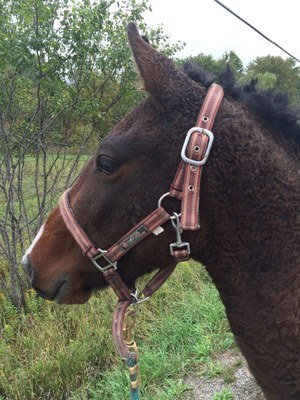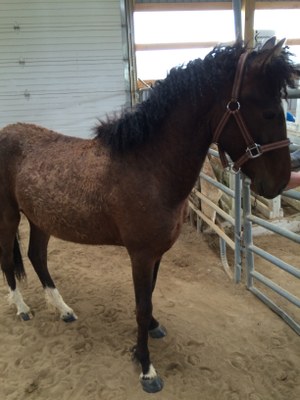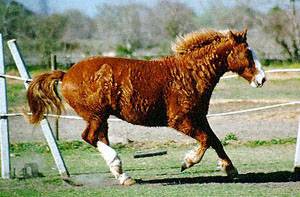Bashkir Curly Horses
 The exact origin of the Bashkir Curly is one of the greatest mysteries of the horse
world. One of the theories, and the source of their name, is that they are descended
from the Russian Bashkir. However, upon closer examination this does not seem plausible. Shan Thomas, author
of "The Curly Horse in America - Myth and Mystery", in correspondence and consultations
with Russian scientists, the Soviet Union's agriculture department, the Moscow Zoo
and other experts of Russian livestock found unanimous agreement that there was no
curly haired horse from the Bashkir. However they did confirm that the Lokai, found in the Taijikistan region, does sometimes display the characteristic curly
coat. Could the Lokai be the actual originator of the Bashkir Curly breed? That, too,
appears to be almost impossible. No mention of importation of horses were made in
ship's logs which brought Russian settlers to the west coast of North America. In
addition, horses were only used to a limited extent in Russian agriculture during
the late 1700's and early 1800's. Stock breeding was not very successful and most
settlements were only able to keep a few livestock. In 1817 there were only sixteen
horses in Russian America. Goods were transported to Okhotsk, the major Russian port
for ships bound for Alaska, via pack horses. At the time, a trip across Siberia to
this port was very hazardous and nearly half of the horses died each year. The horses
of this region were the Yakut, named after the local people. So it seems that any horses that might have been brought
from Russia to Alaska would have been of the Yakut breeding not the Bashkir or Lokai
breeds, both of which are originated from much further south and west of the Yakut.
The exact origin of the Bashkir Curly is one of the greatest mysteries of the horse
world. One of the theories, and the source of their name, is that they are descended
from the Russian Bashkir. However, upon closer examination this does not seem plausible. Shan Thomas, author
of "The Curly Horse in America - Myth and Mystery", in correspondence and consultations
with Russian scientists, the Soviet Union's agriculture department, the Moscow Zoo
and other experts of Russian livestock found unanimous agreement that there was no
curly haired horse from the Bashkir. However they did confirm that the Lokai, found in the Taijikistan region, does sometimes display the characteristic curly
coat. Could the Lokai be the actual originator of the Bashkir Curly breed? That, too,
appears to be almost impossible. No mention of importation of horses were made in
ship's logs which brought Russian settlers to the west coast of North America. In
addition, horses were only used to a limited extent in Russian agriculture during
the late 1700's and early 1800's. Stock breeding was not very successful and most
settlements were only able to keep a few livestock. In 1817 there were only sixteen
horses in Russian America. Goods were transported to Okhotsk, the major Russian port
for ships bound for Alaska, via pack horses. At the time, a trip across Siberia to
this port was very hazardous and nearly half of the horses died each year. The horses
of this region were the Yakut, named after the local people. So it seems that any horses that might have been brought
from Russia to Alaska would have been of the Yakut breeding not the Bashkir or Lokai
breeds, both of which are originated from much further south and west of the Yakut.
Another theory is that the ancestor of the Bashkir Curly might have crossed the land bridge during the last Ice Age. But there is no fossil evidence to support the existence of horses in the America's from the last Ice Age until the reintroduction of horses to this hemisphere by the Spanish.
Several other hypotheses as to the origins of the Bashkir Curly exist but all have failed to be proven creditable upon closer examination, or simply remain untested. In separate research the CS Fund has done blood typing on 200 curly horses in the Serology Lab at UC-Davis. Although one can not definitively identify a horse's breed by its bloodtype characteristics there are characteristics common to an individual breed. This testing was seen as a method to determine if the Bashkir Curly did in fact display the blood characteristics of a distinct breed.
There were no findings which would identify the Bashkir Curly as a genetically distinct breed. The typing showed that many other breeds have been used in their development, particularly Quarter Horses and Morgans. The rare and unusual variants that did emerge from this testing are found only in feral horses or those breeds based on feral herds. No single common blood marker was found.
Formation of the American Bashkir Curly Breed
 Fortunately, the development of the modern Bashkir Curly much more is clearly known.
The modern day history of American Bashkir Curly dates to 1898, when young Peter Damele
(Duh-mel'ly) and his father were riding the Peter Hanson mountain range in the remote
high country of Central Nevada, near Austin. Peter, who passed away in 1981 at age
90, could vividly recall the strange sight they saw of three horses with tight curly
ringlets over their entire bodies. It was intriguing to both father and son as to
where these horses had come from and just why they were there, questions that as you
can see are still not answered. However, from that day to this, there have always
been curly-coated horses on the Damele range, and Peter's son, Benny Damele, continued
to breed them for his ranch work. Many of the Bashkir Curly in the U.S. can be traced
to the Damele herd.
Fortunately, the development of the modern Bashkir Curly much more is clearly known.
The modern day history of American Bashkir Curly dates to 1898, when young Peter Damele
(Duh-mel'ly) and his father were riding the Peter Hanson mountain range in the remote
high country of Central Nevada, near Austin. Peter, who passed away in 1981 at age
90, could vividly recall the strange sight they saw of three horses with tight curly
ringlets over their entire bodies. It was intriguing to both father and son as to
where these horses had come from and just why they were there, questions that as you
can see are still not answered. However, from that day to this, there have always
been curly-coated horses on the Damele range, and Peter's son, Benny Damele, continued
to breed them for his ranch work. Many of the Bashkir Curly in the U.S. can be traced
to the Damele herd.
Establishing the American Bashkir Curly Registry in 1971, the founders set out to save these animals from extinction in the U.S., as it was found that too many of them, through ignorance, were being slaughtered. They then began the process of establishing breeding traits. To accomplish this U.S owners were asked to list the characteristics unique to the Bashkir Curly. These, when compiled, brought out several interesting features of the breed. One especially odd feature of the breed is the fact that they can completely shed out the mane hair (and sometimes even the tail hair) each summer, to grow back during the winter. Even though the mane hair is usually extremely fine and soft, it is quite kinky, and this ability to shed the mane is perhaps nature's way of coping with the corkscrew curls, as it would become quite impossible to manage if it became matted through years of growth. Too, their body coat sheds out in the summer and they become wavy or fairly straight on their body, with their distinctive winter coat returning in late fall. Several winter coat patterns have been observed, from crushed velvet effect, to a perfect marble wave, to extremely tight ringlets over the entire body.
The Bashkir Curly transmits the curly characteristic to its offspring about fifty percent of the time, even when mated to horses without the curly coat. They also seem to be a hardy breed and able to survive severe winter conditions. In the winter of 1951-52, the Curly horses were the only ones to survive on the range of Nevada without supplemental feeding.
 Bashkir Curly's appear in all common horse colors including Appaloosa and Pinto. Physically
they are of medium size, somewhat resembling the early day Morgan in conformation,
and a number of traits have been found in this unique breed that links them to primitive
horses. Many individuals have been found without ergots. Some have small, soft chestnuts.
Their eyes have the wide set eyes characteristic of Oriental breeds. This is said
to give them a wider range of vision. They are described as having tough, black hoofs
are almost perfectly round in shape; an exceptionally high concentration of red blood
cells; stout round-bone cannon; straight legs that also move straight; flat knees;
strong hocks; short back which indicates five lumbar vertebrae; round rump without
crease or dimple; powerful rounded shoulders; V'd chest and round barrel. The foals
arrive with thick, crinkly coats, curls inside their ears and curly eyelashes.
Bashkir Curly's appear in all common horse colors including Appaloosa and Pinto. Physically
they are of medium size, somewhat resembling the early day Morgan in conformation,
and a number of traits have been found in this unique breed that links them to primitive
horses. Many individuals have been found without ergots. Some have small, soft chestnuts.
Their eyes have the wide set eyes characteristic of Oriental breeds. This is said
to give them a wider range of vision. They are described as having tough, black hoofs
are almost perfectly round in shape; an exceptionally high concentration of red blood
cells; stout round-bone cannon; straight legs that also move straight; flat knees;
strong hocks; short back which indicates five lumbar vertebrae; round rump without
crease or dimple; powerful rounded shoulders; V'd chest and round barrel. The foals
arrive with thick, crinkly coats, curls inside their ears and curly eyelashes.
In recent years the Bashkir Curly has performed well in a wide range of equestrian events including Barrel Racing, Pole Bending, Western Riding, Reining, Gymkhana Events, Hunter, Jumper, Roping, English Equitation, Western Pleasure, Gaited Pleasure, Competitive and Endurance Trail Riding, Dressage and Driving.
Registries and Breed Associations
Canada
Canadian Curly Horse Association
RR1
Bowden, AB
TOM OKO
Phone: (403) 224-3895
Germany
Curly Horse Association Germany (CHA e.V.)
Plaeckertstr. 17
D 73061 Ebersbach
Germany
Email: Kaercher@curly-horse.de
United States
American Bashkir Curly Registry
P.O. Box 246
Ely, NV 89301
International Curly Horse Organization
Registry of the North American Curly Horse
2690 Carpenter Rd
Jamestown, OH 45335
Email: office@curlyhorses.org
References
American Minor Breeds Conservancy News, "Curly Horse Mystery Remains Unsolved", Laurie Heise, Nov-Dec, 1989, Vol. 7, No. 1 [Livestock Conservancy]
Hendricks, Bonnie L., International Encyclopedia of Horse Breeds, Univ of Oklahoma Press, 1995
Correspondence: Kentucky Horse Park, Lexington, KY
